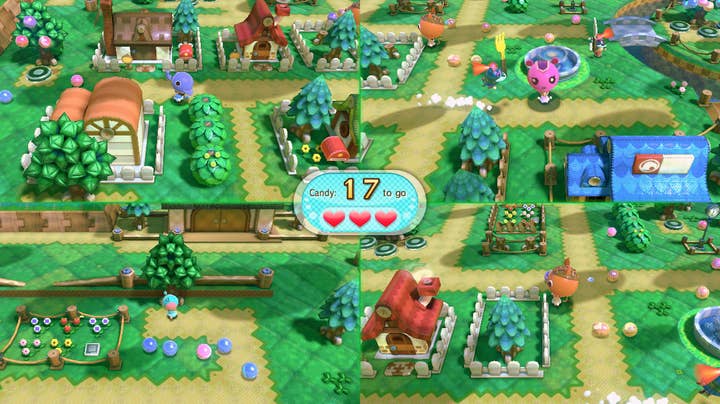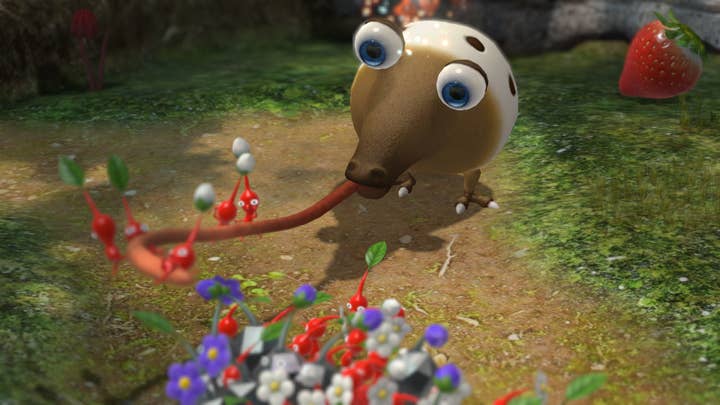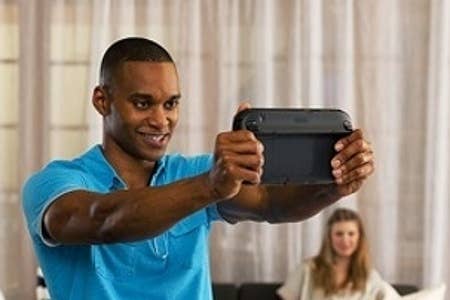Critical Consensus: Wii U
After a disappointing E3 press conference, a lack of compelling software left many critics unconvinced about Nintendo's new console
The conversation about 'Who won E3?' may be too insular to have any real weight, but this year Nintendo seemed certain of that hollow victory. With Sony and Microsoft ruling out any discussion of their next consoles, and EA and Ubisoft occupying a lower tier in terms of general importance, most predicted that Nintendo would emerge as the leader on the basis of having anything to say at all.
But it wasn't to be. As the last few attendees leave Los Angeles for another year, the general consensus is that Ubisoft's press conference stole the show. An invigorating blend of smart AAA franchises, energetic casual titles and genuinely intriguing new IP, the publisher deserves every word of praise being heaped upon it. However, the fact remains that it was Nintendo's battle to lose, and while it would be easy to place all of the blame on its dubious presentational skills, the general malaise surrounding the Wii U could be found in the majority of hands-on reports to surface in its aftermath.
According to The Verge, the problem isn't the hardware itself. An entire year has elapsed since we were given our first glimpse of the Wii U, and in that time Nintendo has made a number of subtle refinements to the GamePad - including a near-field communication button - resulting in a slimmer, lighter and substantially different design to its predecessor.
"It is suggested that changing weapons in Ninja Gaiden is made much easier by tapping the required icon on the GamePad screen. We're not yet convinced"
Edge magazine
"The version that will ship with the diminutive console has vastly improved thumbsticks that can also be pressed in to serve as buttons... The GamePad's original design, while relatively sleek, also felt precarious when holding the controller sideways. This retail design solves that issue with plastic moulded grips built into the backside of the controller. A ridge of plastic about a quarter of the way up from the bottom of the back of the device can be easily gripped when holding the controller sideways."
The shoulder buttons have been redesigned, the face buttons and d-pad have also been changed and shifted further towards the screen. "The end result is a controller that feels very comfortable to hold and game with," and we now know that two people will be able to use GamePad's the same time. For what it's worth, Nintendo has done a fine job on the form-factor.
But the look and feel of the hardware is a distant second to the games, and in that respect the reaction has been far less enthusiastic. Shigeru Miyamoto's charming demonstration of Pikmin 3 is universally accepted as both the highlight of Nintendo's press conference and the single most promising piece of software for Wii U. Look beyond that, however, and most journalists have struggled to dole out unqualified praise.

The problem is simple: few people understood the Wii before they encountered Wii Sports, and it stands to reason that the Wii U needs its own great communicator. However, the Wii U only has the fun but considerably less persuasive Nintendo Land.
"It seemed exactly the kind of casual carousel gamers associate with Wii software, and to say the least, it was not what those people were hoping for," writes Eurogamer's Oli Welsh, who has a generously proportioned soft-spot for Nintendo's products.
"Nintendo's new console is a strange concept that needs a game to explain it to people, but it has so many facets and possibilities that it can't be explained by a single game. And you have to give Nintendo some credit for at least attempting to foreground gameplay ideas such as asymmetric multiplayer. However, it's also true that Nintendo Land comes off a little unfocused, more Wii Play than Wii Sports, with the conceit of a Nintendo theme park featuring favourite franchises only just managing to tie it together."
There are games based on Donkey Kong, Luigi, Animal Crossing and Zelda among others, and Welsh acknowledges that many of them clearly demonstrate the ability of Nintendo's Kyoto team to realise design concepts and perfect new control schemes. However, it's the notion that this could be the Wii U's tentpole launch title that really stirs the feelings of uncertainty.
"Like Wii Sports, Nintendo Land will be a good game that's unfairly dismissed by many. However, I just can't see it defining a console and changing games as Wii Sports did"
Oli Welsh, Eurogamer
"Attendees are having fun with it on the show floor, but it only demonstrates a handful of light concepts, it does so in a fragmented way, and with the best will in the world, it's just not very sexy... Like Wii Sports, Nintendo Land will be a good game that's unfairly dismissed by many. However, I just can't see it defining a console and changing games as Wii Sports did. Its ideas are too scattered, its selling point too hard to grasp. Perhaps that's also true of Wii U itself - and if so, it could be tough times ahead for Nintendo."
Indeed, Wii Sports was such a powerful demonstration of its console's technology that it managed to sell tens of millions of units almost single-handed. Even as its life-cycle draws to a close, relatively few third-party developers managed to take full advantage of the Wii's motion controls, and for Edge magazine, the Wii U presents a far stiffer creative challenge.
With the Wii Motion Plus now firmly established, and the GamePad featuring a dizzying array of possible inputs, "it's easy to imagine game developers not knowing where to begin." In Edge's view, the only playable experiences that offer a glimpse of the asymmetrical gaming the Wii U is built upon are a handful of mini-games in Nintendo Land, but the same can't be said of its third-party offerings.
"The two highest-profile Wii U exclusives from third-party publishers at E3, Lego City: Undercover and ZombiU, are more at home simply clearing traditional clutter from the main screen and pushing it onto the one between your hands. As you'd expect, it's a route also taken by Batman Arkham City: Armored Edition and Ninja Gaiden 3: Razor's Edge, both built on games already in existence and therefore less likely to confound expectations."

The reduction of clutter on the TV screen is certainly welcome, but the resulting play experience, "isn't immediately comfortable." The DS asked gamers to move their eyes just a few inches, but certain Wii U games require you to shift your gaze from a large screen before you to a small one in your lap to perform even the most basic gameplay functions. If developers are going to ask players to do so, they need to provide a more compelling reason than just switching weapons or managing inventory.
"It is suggested during our demo that changing weapons in Ninja Gaiden is made much easier and quicker by being able to tap the required icon on the GamePad screen. Easier than it would be to, say, tap a direction on a D-pad while not moving your gaze from the TV? We're not yet convinced."
Of course, this is just a sample. It is impossible to pass any lasting judgement on a console based on a few stolen hours at a crowded trade show, with only a small slice of the games that will be available at launch. However, if Nintendo intends to launch the Wii U this year E3 will be its most important opportunity to send a positive message to consumers. And whenever Nintendo find itself on that sort of knife-edge, it is able to turn to perhaps the greatest weapon of any company on the industry: Mario.
"There is no Wii Sports among the Wii U games I played. There is no game that I think people will fall in love with the moment the Wii U is released later this year"
Stephen Totilo, Kotaku
In Super Mario Bros. U, Nintendo has a game that the enthusiasts will expect to make intelligent use of the system's capabilities, and the masses will stand in line to buy. In its most iconic character, Nintendo has the ultimate sugar pill to help make its message more palatable. Yet Kotaku's Stephen Totilo believes that it shows Nintendo missing a gilt-edged opportunity to push the Wii U's concept. It is enjoyable, of course, but only in the most familiar way, and that isn't what the the console requires.
"Nintendo reps boast that this will be the first Mario game to launch with a Nintendo console since the Nintendo 64's Super Mario 64. This game is no Super Mario 64," he writes. "Rather, it feels as predictable and obvious as Nintendo could be and lacks, in the pair of E3 demo levels I saw, freshness. The game looks and plays like New Super Mario Bros. Wii which itself was barely distinct from the Nintendo DS' New Super Mario Bros..
"This feels not like a Super Mario World or Super Mario Galaxy evolution of a great series but more like a Call of Duty-conservative tweaking of a popular thing. This is, in other words, sadly, the safest Nintendo launch game I think I've ever seen.
"Perhaps Nintendo designers believe that Wii U gamers will need something as comfortably formulaic as New Super Mario Bros. U to clearly demonstrate how a Wii U game can differ from the many single-screen TV console games we've played for years, but this really feels like a re-tread with an added gimmick. Worse, Ubisoft's Rayman Legends which does the same side-scroller asymmetrical, co-op multiplayer straight-up looks better and looks more fun.
"There is no Wii Sports among the Wii U games I played. There is no game that I think people will fall in love with the moment the Wii U is released later this year."

